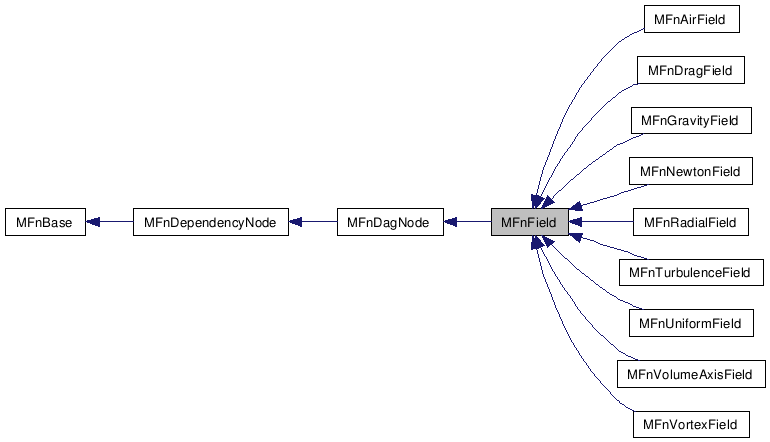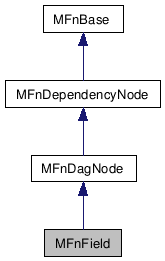MFnField Class Reference
[OpenMayaFX - API module for effects]
#include <MFnField.h>


Detailed Description
Function set for Dynamic Fields.Function set for creation, edit, and query of Dynamic Fields.
There are several types of dynamic fields: Air, Drag, Gravity, Newton Radial, Turbulence, Uniform, and Vortex.
Public Member Functions | |
| virtual MFn::Type | type () const |
| Function set type. | |
| virtual | ~MFnField () |
| Destructor. | |
| MFnField () | |
| Default constructor. | |
| MFnField (MObject &object, MStatus *ReturnStatus=NULL) | |
| Constructor. | |
| MFnField (const MDagPath &object, MStatus *ret=NULL) | |
| Constructor. | |
| MStatus | getForceAtPoint (const MPointArray &point, const MVectorArray &velocity, const MDoubleArray &mass, MVectorArray &force, double deltaTime=1.0/24.0) |
| MStatus | getForceAtPoint (const MVectorArray &point, const MVectorArray &velocity, const MDoubleArray &mass, MVectorArray &force, double deltaTime=1.0/24.0) |
| double | magnitude (MStatus *ReturnStatus=NULL) const |
| MStatus | setMagnitude (double mag) |
| double | attenuation (MStatus *ReturnStatus=NULL) const |
| MStatus | setAttenuation (double atten) |
| double | maxDistance (MStatus *ReturnStatus=NULL) const |
| MStatus | setMaxDistance (double maxDist) |
| bool | perVertex (MStatus *ReturnStatus=NULL) const |
| MStatus | setPerVertex (bool enable) |
| bool | useMaxDistance (MStatus *ReturnStatus=NULL) const |
| MStatus | setUseMaxDistance (bool enable) |
| double | falloffCurve (const double param, MStatus *ReturnStatus=NULL) |
| bool | isFalloffCurveConstantOne (MStatus *ReturnStatus=NULL) |
| MFnField (const MObject &object, MStatus *ret=NULL) | |
| Constructor. | |
Protected Member Functions | |
| virtual const char * | className () const |
| Class name. | |
Constructor & Destructor Documentation
| MFnField::~MFnField | ( | ) | [virtual] |
Destructor.
Class destructor.
Constructor.
Class constructor that initializes the function set to the given MObject.
- Parameters:
-
[in] object The MObject to attach the function set to [out] ReturnStatus the return status
- Status Codes:
- MS::kSuccess if the function set is successfully attached
- MS::kInvalidParameter if the MObject does not represent a valid Maya object or if the function set is not allowed to attach to this MObject
Constructor.
Class constructor that initializes the function set to the given constant MDagPath object.
- Parameters:
-
[in] object The const MDagPath to attach the function set to [out] ReturnStatus The return status
- Status Codes:
- MS::kSuccess if the function set is successfully attached
- MS::kInvalidParameter if the MObject does not represent a valid Maya object or if the function set is not allowed to attach to this MObject
Constructor.
Class constructor that initializes the function set to the given MObject.
- Parameters:
-
[in] object The MObject to attach the function set to [out] ReturnStatus the return status
- Status Codes:
- MS::kSuccess if the function set is successfully attached
- MS::kInvalidParameter if the MObject does not represent a valid Maya object or if the function set is not allowed to attach to this MObject
Member Function Documentation
| MFn::Type MFnField::type | ( | ) | const [virtual] |
Function set type.
Return the class type : MFn::kField
Reimplemented from MFnDagNode.
Reimplemented in MFnAirField, MFnDragField, MFnGravityField, MFnNewtonField, MFnRadialField, MFnTurbulenceField, MFnUniformField, MFnVolumeAxisField, and MFnVortexField.
| MStatus MFnField::getForceAtPoint | ( | const MPointArray & | point, | |
| const MVectorArray & | velocity, | |||
| const MDoubleArray & | mass, | |||
| MVectorArray & | force, | |||
| double | deltaTime = 1.0 / 24.0 | |||
| ) |
Compute the force of a field on an array of points, given their position, velocity, and mass. Note that only the Air and Vortex fields require a time increment to compute forces, all other fields will ignore this argument.
This method uses MPointArray to represent the positions of points. If a point instance is in a rational form or a homogenous form, you should reset it to be in the cartesian form P(x, y, z, 1).
- Parameters:
-
[in] point array of positions for each point. [in] velocity array of velocities for each point. If the length of the velocity array is 0, a velocity of 0.0 is assumed for all the points. Note the velocity array is a requirement for the Air and Drag fields to compute forces. [in] mass array of mass values for each point. If the length of the mass array is 0, a mass of 1.0 is assumed for all the points. [out] force output array of forces applied to each point. If the length of the force array supplied is 0, the array is automatically resized. If the contents of the force array contains data, the computed force is added to the supplied data. This can be useful to accumulate forces of multiple fields. [in] deltaTime time increment in seconds for usage with the Air and Vortex fields. Default is (1.0 / 24.0 fps).
- Returns:
- Status code
- Status Codes:
- MS::kSuccess The method was successful.
- MS::kFailure An object error has occurred.
| MStatus MFnField::getForceAtPoint | ( | const MVectorArray & | point, | |
| const MVectorArray & | velocity, | |||
| const MDoubleArray & | mass, | |||
| MVectorArray & | force, | |||
| double | deltaTime = 1.0 / 24.0 | |||
| ) |
Compute the force of a field on an array of points, given their position, velocity, and mass. Note that only the Air and Vortex fields require a time increment to compute forces, all other fields will igonore this argument.
This method uses MVectorArray to represent the positions of a point.
- Parameters:
-
[in] point array of positions for each point. [in] velocity array of velocities for each point. If the length of the velocity array is 0, a velocity of 0.0 is assumed for all the points. Note the velocity array is a requirement for the Air and Drag fields to compute forces. [in] mass array of mass values for each point. If the length of the mass array is 0, a mass of 1.0 is assumed for all the points. [out] force output array of forces applied to each point. If the length of the force array supplied is 0, the array is automatically resized. If the contents of the force array contains data, the computed force is added to the supplied data. This can be useful to accumulate forces of multiple fields. [in] deltaTime time increment in seconds for usage with the Air and Vortex fields. Default is (1.0 / 24.0 fps).
- Returns:
- Status code
- Status Codes:
- MS::kSuccess The method was successful.
- MS::kFailure An object error has occurred.
| double MFnField::magnitude | ( | MStatus * | ReturnStatus = NULL |
) | const |
Returns the strength of the field.
- Parameters:
-
[out] ReturnStatus Status code
- Returns:
- A value representing the strength of the field.
- Status Codes:
- MS::kSuccess The method was successful.
- MS::kFailure An object error has occurred.
| MStatus MFnField::setMagnitude | ( | double | mag | ) |
Sets the strength of the field.
- Parameters:
-
[in] mag A value representing the strength of the field.
- Returns:
- Status code
- Status Codes:
- MS::kSuccess The method was successful.
- MS::kFailure An object error has occurred.
| double MFnField::attenuation | ( | MStatus * | ReturnStatus = NULL |
) | const |
Returns the rate of change where the strength of the field changes as the distance between the field and the affected object increases.
- Parameters:
-
[out] ReturnStatus Status code
- Returns:
- A positive value representing the exponent for rate of change.
- A value of 0 and the force remains constant over distance.
- Status Codes:
- MS::kSuccess The method was successful.
- MS::kFailure An object error has occurred.
| MStatus MFnField::setAttenuation | ( | double | atten | ) |
Sets the rate of change where the strength of the field changes as the distance between the field and the affected object increases.
- Parameters:
-
[in] atten A positive value representing the exponent for rate of change. A value of 0 and the force remains constant over distance.
- Returns:
- Status code
- Status Codes:
- MS::kSuccess The method was successful.
- MS::kFailure An object error has occurred.
| double MFnField::maxDistance | ( | MStatus * | ReturnStatus = NULL |
) | const |
Returns the maximum distance from the field at which the force of the field is exerted. The Use Max Distance setting must be turned on for maximum distance to take effect. The maximum distance is scaled by the falloff curve's non-zero range.
- Parameters:
-
[out] ReturnStatus Status code
- Returns:
- A value representing distance in internal linear units.
- Status Codes:
- MS::kSuccess The method was successful.
- MS::kFailure An object error has occurred.
| MStatus MFnField::setMaxDistance | ( | double | dist | ) |
Sets the maximum distance from the field at which the force of the field is exerted. The Use Max Distance setting must be turned on for maximum distance to take effect.
- Parameters:
-
[in] dist A value representing distance in internal linear units.
- Returns:
- Status code
- Status Codes:
- MS::kSuccess The method was successful.
- MS::kFailure An object error has occurred.
| bool MFnField::perVertex | ( | MStatus * | ReturnStatus = NULL |
) | const |
Returns true if the field exerts its force on each individual point (cv, particle, vertex) equally. Returns false if the force is exerted only from the geometric center of the object or set of points.
- Parameters:
-
[out] ReturnStatus Status code
- Returns:
- true Force is applied to each individual point.
- false Force is applied from the geometric center.
- Status Codes:
- MS::kSuccess The method was successful.
- MS::kFailure An object error has occurred.
| MStatus MFnField::setPerVertex | ( | bool | enable | ) |
Enables the field to exert its force on each individual point (cv, particle, vertex) equally. Otherwise, the force is exerted only from the geometric center of the object or set of points.
- Parameters:
-
[in] enable Flag to enable or disable individual point forces.
- Returns:
- Status code
- Status Codes:
- MS::kSuccess The method was successful.
- MS::kFailure An object error has occurred.
| bool MFnField::useMaxDistance | ( | MStatus * | ReturnStatus = NULL |
) | const |
Returns true if the field will use the maximum distance setting to determine the area of influence.
- Parameters:
-
[out] ReturnStatus Status code
- Returns:
- true Field uses the maximum distance setting.
- false Field ignores the maximum distance setting.
- Status Codes:
- MS::kSuccess The method was successful.
- MS::kFailure An object error has occurred.
| MStatus MFnField::setUseMaxDistance | ( | bool | enable | ) |
Enables the field to use the maximum distance setting to determine the area of influence.
- Parameters:
-
[in] enable Flag to enable or disable maximum distance.
- Returns:
- Status code
- Status Codes:
- MS::kSuccess The method was successful.
- MS::kFailure An object error has occurred.
| double MFnField::falloffCurve | ( | const double | param, | |
| MStatus * | ReturnStatus = NULL | |||
| ) |
Returns falloff given the param in [0,1]. This is enabled if the use the maximum distance is enabled.
- Parameters:
-
[in] param Parameter [out] ReturnStatus Status code
- Returns:
- The falloff value given the param.
- Status Codes:
- MS::kSuccess The method was successful.
- MS::kFailure An object error has occurred.
| bool MFnField::isFalloffCurveConstantOne | ( | MStatus * | ReturnStatus = NULL |
) |
Returns true if falloffCurve is a constant one (default) or false if not.
- Parameters:
-
[out] ReturnStatus Status code
- Returns:
- If falloff curve always returns a constant one
- Status Codes:
- MS::kSuccess The method was successful.
- MS::kFailure An object error has occurred.